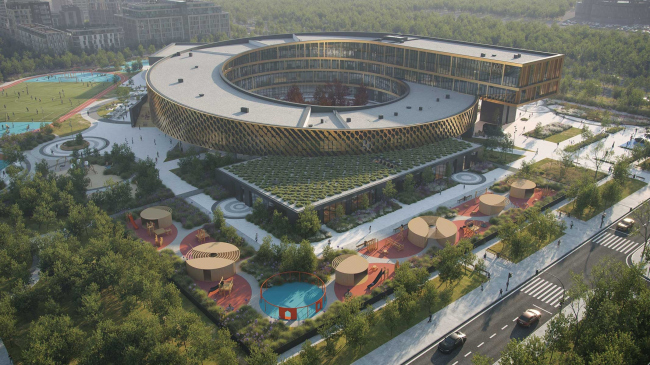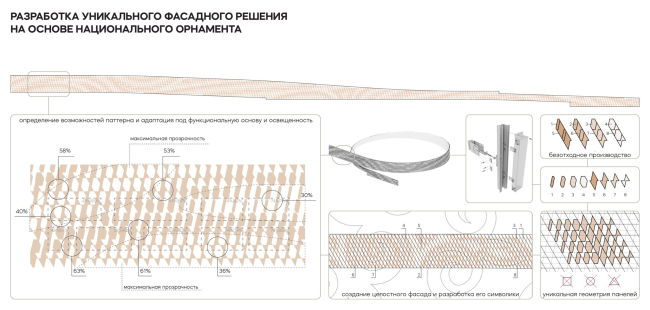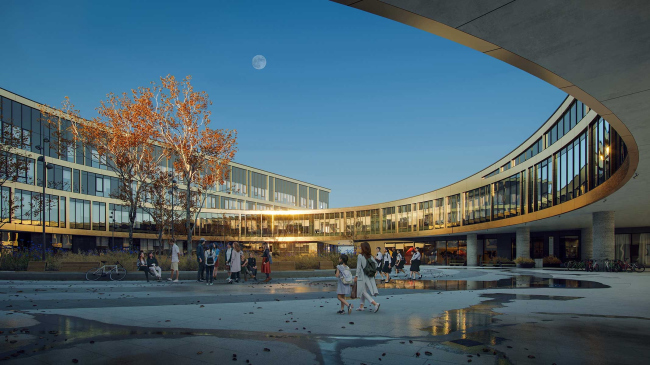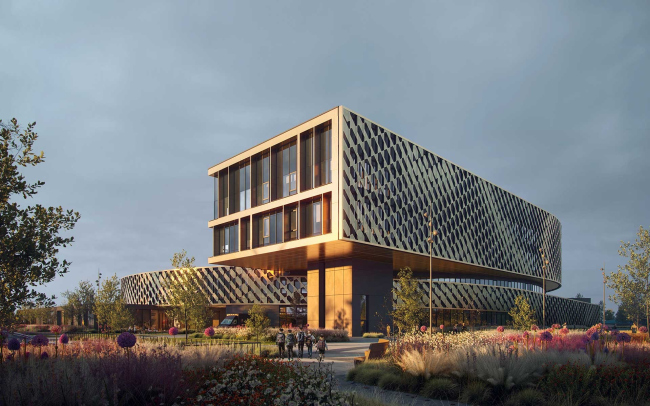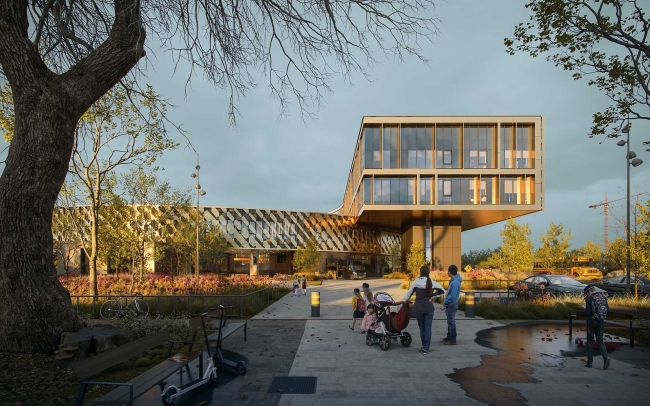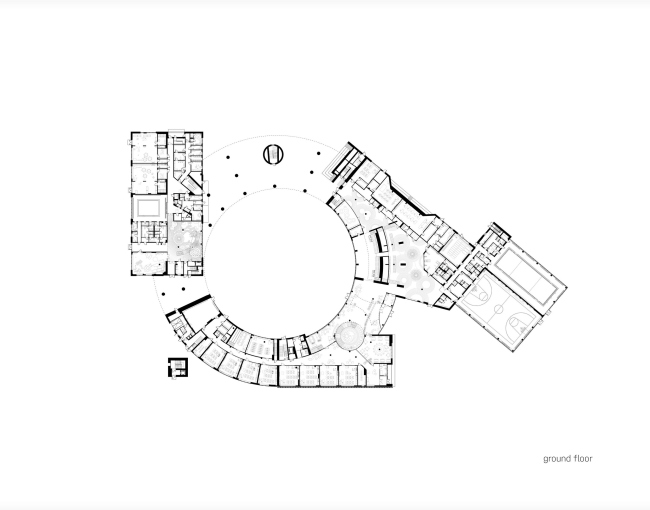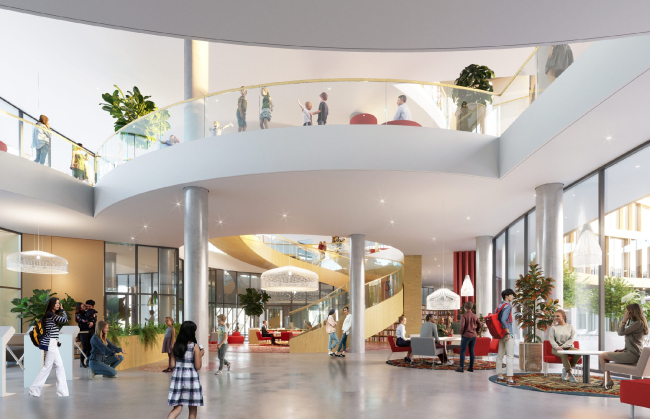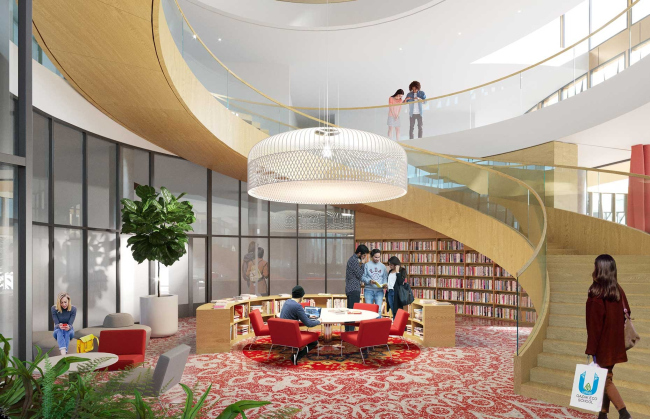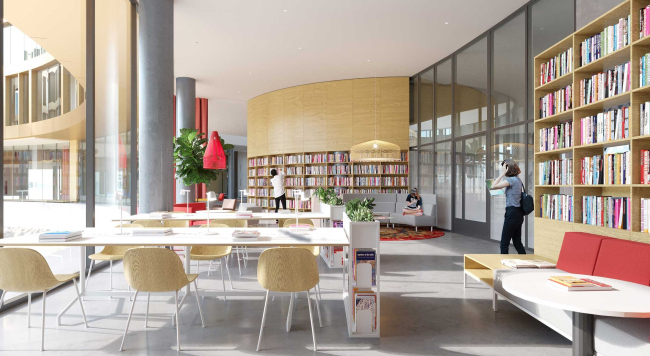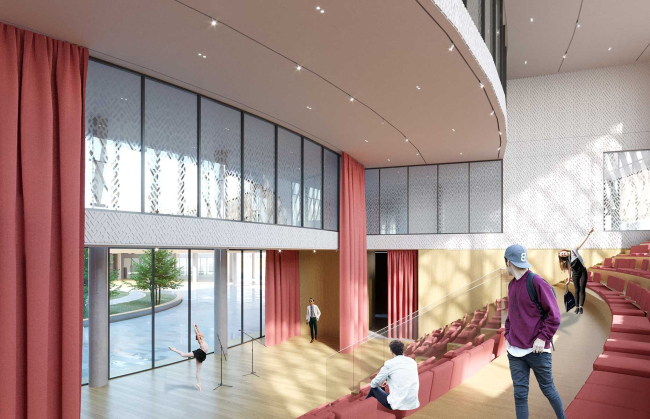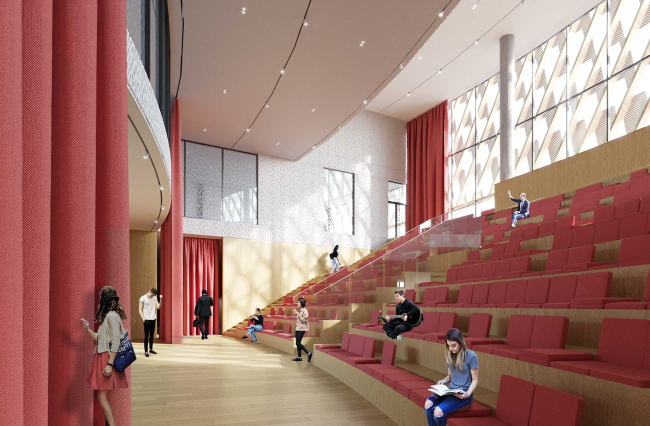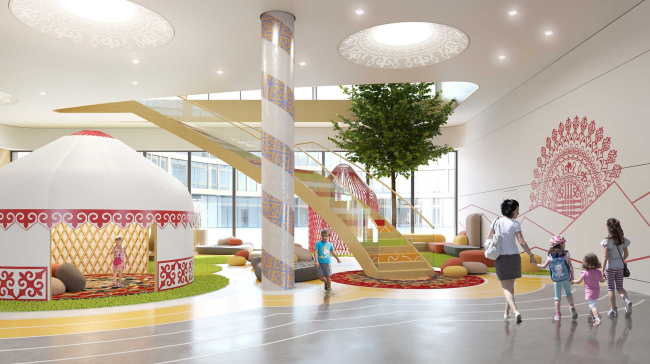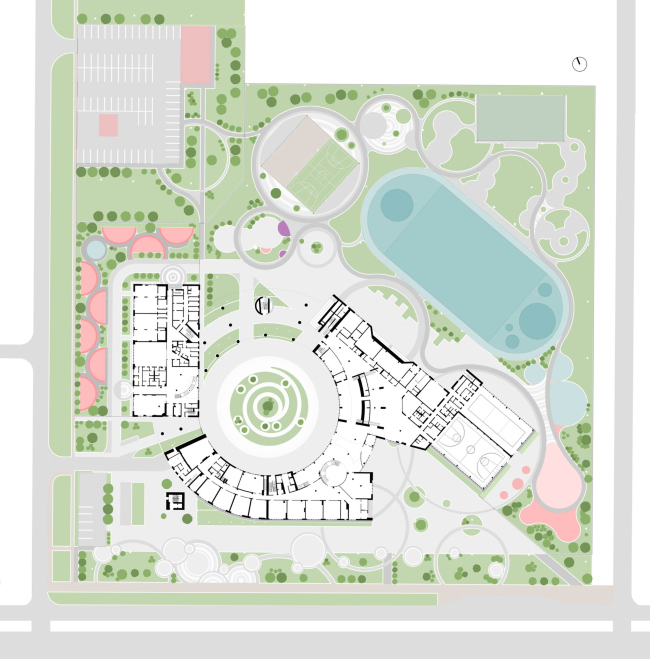|
Published on Archi.ru (https://archi.ru) |
|
| 16.08.2021 | |
|
The Spiral Approach |
|
|
Julia Tarabarina |
|
| Architect: | |
| Vera Butko | |
| Anton Nadtochiy | |
| Studio: | |
| ATRIUM | |
|
The school building in the city of Nur-Sultan, designed by Vera Budko and Anton Nadtochiy from beginning to end – from concept to working documentation – became the embodiment of the architects’ method for creating a modern educational environment, which the ATRIUM architects have been developing for years. Its fundamentals include creating an inspiring environment that motivates you to create. This is why the new school received a shape of an ornamental golden spiral that symbolizes ascension to knowledge; on the inside, the building is a compound and multifunctional “city within a city” with multilevel atriums, amphitheaters, and varying routes. The building of the educational complex is being built in the southern part of the capital of Kazakhstan, the city of Nur-Sultan, formerly Astana, not far from the territory of the world EXPO 2017. The customer – the Nursultan Nazarbayev Foundation – interprets the complex as “one of the most modern educational sites in the city”, and the building was to meet the current requirements for educational facilities. It is not surprising that the Moscow-based architectural company ATRIUM, headed by Vera Butko and Anton Nadtochiy, was invited to design it: first, they have been successfully working on various projects in Kazakhstan for years, and second, for more than 15 years they have been designing modern educational spaces, combining the plastique and spatial architecture of buildings with functional programming based on their own research. The location plan. The educational complex in Nur_Sultan, a project, 2020Copyright: © ATRIUMAnother wish expressed by the customers, in addition to the modern approach to the design of the complex, was to immerse its architecture in the tradition of Kazakhstan, which springs from the culture of the Turkic peoples in general. In addition, the building had to comply with the principles of the Vastu philosophy, the Hindu variety of the more famous Feng Shui, a doctrine tuned to the optimal organization of space for a correct and happy life. Orientation of entrances and exits to the cardinal points is based on the principles of Vastu, and, most importantly, the volume is designed in the shape of a spiral, symbolizing the ascent to knowledge. The educational complex in Nur_Sultan, a project, 2020Copyright: © ATRIUMThe spiral is “spun” clockwise around the yard, ending in a cantilevered structure on the level of the 3 and 4 floors – its head is “turned” westward, in the direction of EXPO and sunsets. On the whole, the building resembles a fibula, a hairpin buckle likely will those that are found in the steppe mounds: this similarity is emphasized by the golden shell of the facade, made up of eight types of perforated elements. According to Anton Nadtochiy, the design of the facade is parametrically planned, the pattern based on the Kazakh national ornament smoothly dissolves, providing school classes with adequate lighting and emergency exits. What we are seeing is not just a popular technique of ornamental perforation, but a smooth, smartly calculated combination of volumetric elements of several types that form an ornament. Forming the pattern. The educational complex in Nur_Sultan, a project, 2020Copyright: © ATRIUMThe educational complex in Nur_Sultan, a project, 2020Copyright: © ATRIUMAt the same time, thanks to its “wrapping” properties, the shell emphasizes the unity of the round shape of the “ring” building, just as its Turkic identity – the circular volume is “enshrouded” into metallic decor. You can compare it to ripples on the water, and with the swinging of pendants in a traditional hat – this is how a modern generalized variation of a motif arises, devoid of trivial literalness. The spacious circular inner yard is not just a place for walking and informal communication, popular in modern school buildings: in this instance, it is also meant to give projection from the strong winds, characteristic for the local nature. The yard can be accessed from the central atrium, and from the complex as well. The facades of the yard are devoid of ornamentation, and essentially consist of panoramic glazing, golden interfloor bands, and slender asymmetric molds – this more transparent “inner” matter spills over to the facade of the cantilevered structure. The educational complex in Nur_Sultan, a project, 2020Copyright: © ATRIUMThe educational complex in Nur-Sultan, a project, 2020Copyright: © ATRIUMDespite the spiral shape of the volume and the metaphor of ascent, the floors are not sloping inside: the rise is provided by a smooth increase in floors from two to four – this is made in the cantilevered structure which will host an additional 1000 square meters of administrative premises related to the educational activities of the branch of the foundation that is building this school. This function is unusual in a school building, and the office area, although connected to the school space, has an independent entrance via a staircase and an elevator placed in the supporting column beneath the cantilever. The educational complex in Nur_Sultan, a project, 2020Copyright: © ATRIUMThe educational complex in Nur_Sultan, a project, 2020Copyright: © ATRIUMVirtually the entire first floor is transparent either visually, though the glass in the atrium zone, or physically – about a third of the volume is occupied by an open space of the “column” legs that allows you to freely move between the outer (fenced) school yard and the circular inner yard. Here, among the slender supports appears another round “leg” with an emergency staircase. In front of the main entrance, a plaza is formed, open to the city, and not surrounded by a traditional school fence – it is formed by the building of the sports complex on the right and a cafe with a public zone on the left. The security checkpoint is situated further down the line, and the parents will be able to wait for their children, talk to teachers, or even organize a parent meeting without having to order a security pass. Plan of the 1st floor. The educational complex in Nur_Sultan, a project, 2020Copyright: © ATRIUMSome extra volumes – the sports complex, the cafe, and the kindergarten – adjoin the main spiral part. Such an approach to creating a volumetric composition of school buildings is currently considered to be one of the best because it allows you to achieve good insolation, as well as to make different parts of the building interconnected thanks to the public hub. The role of such a hub is played in this case by the lobby atrium, the adjoining halls, and the space of the auditorium. The atrium is double-height, visible through; arched balconies of the second tier are strung on round columns, which creates a rather energetic space, as if unfolding before our eyes. On the left, there is a wide spiral staircase, a characteristic modernist method of working with space, which makes it possible both to unite it, and to endow it with an acute spatial intrigue in one movement. In this case, the staircase unites all the four tiers with a library “grouped” around it. Its spiral picks up the main theme of the building, continuing and maintaining the spin. On the sides of the stairs, slots in the interfloor ceilings are grouped -,they echo the double-height atrium in the third and fourth tiers, picking up the baton of the floors’ transparency to the human eye and the ambient light. The educational complex in Nur_Sultan, a project, 2020Copyright: © ATRIUMThe educational complex in Nur_Sultan, a project, 2020Copyright: © ATRIUMThe educational complex in Nur_Sultan, a project, 2020Copyright: © ATRIUMRight of the lobby, there is an amphitheater event hall with a stage next to a glass wall overlooking the yard. The panoramic windows, both down below, near the stage, and up above, behind the amphitheater’s back, provide an extra visual connection with the inner yard and the operated roof. However, these can be covered with a curtain, and, if necessary, the hall can be darkened, for example, for theater lights. The educational complex in Nur_Sultan, a project, 2020Copyright: © ATRIUMJust as the other interiors, the amphitheater features balanced and moderate ornaments – according to the architects, it became the result of working with many options, from minimalist to richly embellished ones. Here, for example, silk printing is rhymed with openwork shadows of the facade patterns. The educational complex in Nur_Sultan, a project, 2020Copyright: © ATRIUMOn regular days, when there are no performances or other school events, the hall, like the space of the library around the stairs, will serve as a recreation space. There is also the possibility of separating the stage, in which case it becomes a theater class, and the amphitheater remains a place of communication. It also serves as another transition point between the tiers inside the building. From the second tier, it will be possible to get to the operated roof in front of the sports complex, from where, turning to the left, in turn, you can go down the steps of another open amphitheater, into the courtyard, and to the stadium. Some of its steps are protected from the sun and rain, some are open, so it will even be possible to conduct outdoor events here. Another amphitheater with a tribune function is built into the building from the side of the stadium. The educational complex in Nur_Sultan, a project, 2020Copyright: © ATRIUMThe ground floor under the amphitheater and partly under the operated roof is also included in the system of public spaces – a winter garden is planned here. Thus, a whole “node” of interconnected spaces with flexible functionality and different emotional charge is grouped around the entrance atrium. 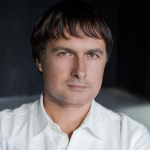 Anton Nadtochiy, ATRIUM Our main task as architects is, first of all, to come up with an interesting space. We strive to create different types of spaces and group them together, avoiding dead ends in order to make sure that you can move in different ways: go down, go up, go outside or get inside. Therefore, we often use amphitheaters – they help to form more scenarios of movement through the building and more connections between levels, both visual and physical passages too. This makes it possible to navigate in optimal ways and at the same time works for a variety of perception, allows you to create intrigue, plasticity and inner complexity. 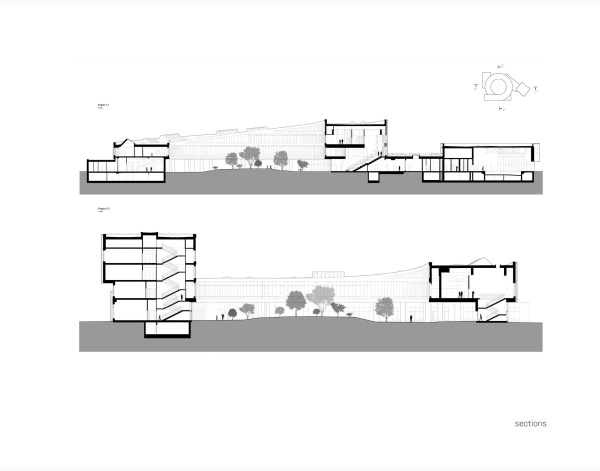 Section views. The educational complex in Nur_Sultan, a project, 2020Copyright: © ATRIUM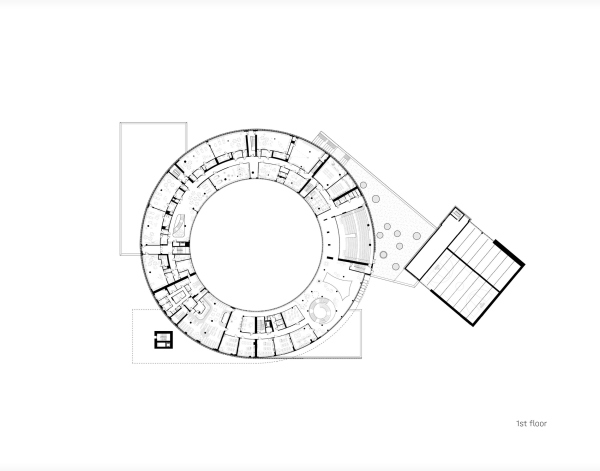 Plan of the 2nd floor. The educational complex in Nur_Sultan, a project, 2020Copyright: © ATRIUM Plan of the 3rd floor. The educational complex in Nur_Sultan, a project, 2020Copyright: © ATRIUM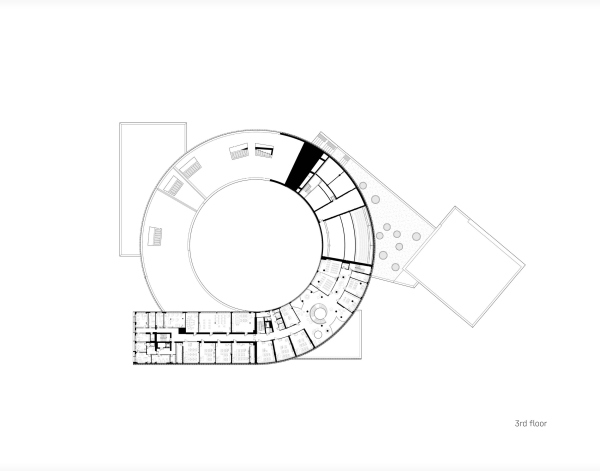 Plan of the 4th floor. The educational complex in Nur_Sultan, a project, 2020Copyright: © ATRIUMThe rectangular volume of the kindergarten is cut into the corner of the main ring and, for obvious reasons, is relatively isolated, but inside it forms its own double-height atrium with a staircase of a smaller size; there is also a swimming pool. Part of the kindergarten is additionally illuminated with skylights to comply with the insolation standards adopted in Kazakhstan. The educational complex in Nur_Sultan, a project, 2020Copyright: © ATRIUMThe improvement of the territory was also developed by Atrium – it continues and develops the ideas that the architecture of the educational center is based upon. The surrounding territory includes two open air stadiums (major and minor), walking trails of the kindergarten, an overland parking lot, which is mandatory, and vegetation that represents various climatic zones of Kazakhstan. The landscape is subjugated to the pattern of many rings, again, national at its core, but at the same time very much in the creative style of ATRIUM. The spiral drawing of the paving plan of the courtyard marks the center of the “whirlpool” of the volume of the school building – like a solar sign. The master plan. The educational complex in Nur_Sultan, a project, 2020Copyright: © ATRIUM*** “Kazakhstan has been going through a baby boom for some time; some families have from five to seven children, and the construction of school buildings became the main governmental priority” – Vera Budko and Anton Nadtochiy share. The architects have already developed for Kazakhstan a strategy for designing school buildings for 2500+ students with a possibility of reuse, which is taken as the basis during the construction of governmental schools. This Nazarbayev Foundation school is different from these projects with a customized approach and a high degree of detailing: in this instance, ATRIUM has worked on all of the stages of the project, from initial sketches to working documentation, including the interior and landscape design, which, as a rule, allows you to efficiently manage the construction process in its entirety – a serious argument in favor of the quality of implementation of the future building. It seems that this grand-scale project has encompassed the architects’ experience in working with national theme and designing school buildings, which have long since become one of the favorite directions of their specialization and their typological research. We will remind you that in July this year the architects received the Moscow Mayor's Prize for the project of the school in the residential complex Symbol, and earlier they were awarded the same prize for the project of the Letovo school. A capacious memorable shape, a bold cantilevered structure, a sophisticated space with the possibility of multifunctional use and a recognizable modernist approach that skillfully absorbs traditional motives – all this adds up to an image of self-development in a broad sense, an ascent to success and personal growth through the development of space and form. The project has already received all the mandatory approvals in Kazakhstan; the building is under construction, and is expected to take in the first students in September 2022. |
|

